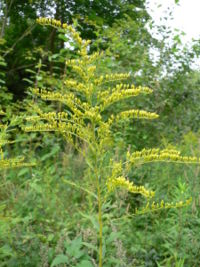Solidago canadensis
| Solidago canadensis subsp. var. | Canada golden-rod, Canada goldenrod | |||||||||||||||||||||||||||||||||||||||||||||||||||||||
|---|---|---|---|---|---|---|---|---|---|---|---|---|---|---|---|---|---|---|---|---|---|---|---|---|---|---|---|---|---|---|---|---|---|---|---|---|---|---|---|---|---|---|---|---|---|---|---|---|---|---|---|---|---|---|---|---|

|
|
| ||||||||||||||||||||||||||||||||||||||||||||||||||||||
| ||||||||||||||||||||||||||||||||||||||||||||||||||||||||
Solidago canadensis (Canada golden-rod, Canada goldenrod) is an herbaceous perennial plant of the family Asteraceae native to North America. It is often grown as a wildflower.
The plant is erect, often forming colonies. Flowers are small yellow heads held above the foliage on a branching inflorescence.
It occurs throughout North America, in most US states and Canadian provinces.[1] It is found in a variety of habitats, although it is not shade tolerant. It typically is one of the first plants to colonize an area after disturbance (such as fire) and rarely persists once shrubs and trees become established. It is found neither in very dry locations nor in waterlogged ones.[1]
In many parts of Europe and China, it is established as an invasive weed.
| Standard Cyclopedia of Horticulture |
|---|
|
Solidago canadensis, Linn. St. 3-5 ft., stout, hairy and usually much branched: lvs. acute at each end, the lower sharply serrate, lanceolate, 3-7 in. long, 3/4 – 1 1/2 in. wide, the upper smaller and often entire: fls. in a very large terminal secund panicle, involucral bracts linear, obtuse or acutish. In dry soil, E. N. Amer.— There are many wild forms but none seems to be in the trade. Aug.-Nov. This is a coarse and somewhat weedy species; very common. CH
|
Cultivation
Propagation
Pests and diseases
Varieties
Gallery
-
photo 1
-
photo 2
-
photo 3
References
External links
- w:Solidago canadensis. Some of the material on this page may be from Wikipedia, under the Creative Commons license.
- Solidago canadensis QR Code (Size 50, 100, 200, 500)
